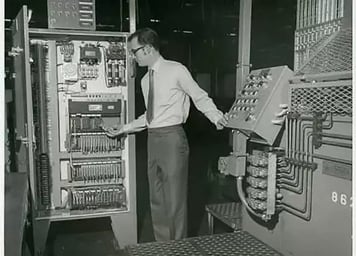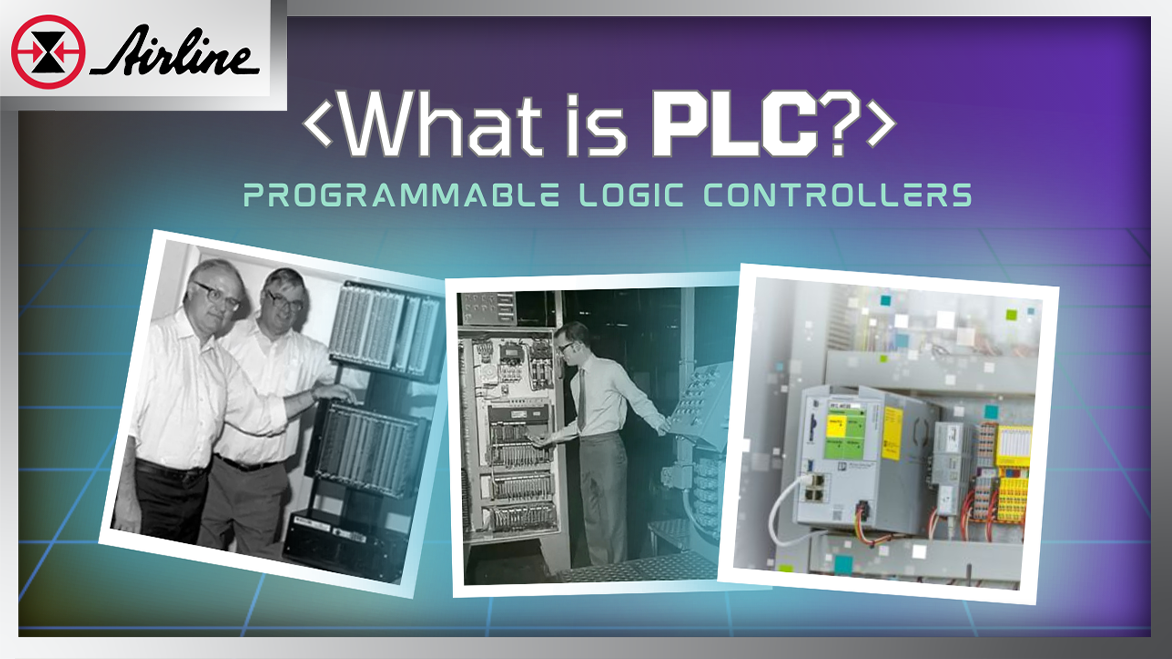Editor's note: This post has been updated in August 2025 for comprehensiveness.
If you’ve been exploring the world of industrial automation, you’ve probably come across the term programmable logic controller, or PLC for short.
These compact yet powerful devices are the brains behind countless automated processes, controlling everything from assembly lines to complex manufacturing equipment.
In this guide, we’ll break down exactly what a programmable logic controller is, why it’s essential in today’s factories, and how it has transformed into a versatile, reliable, and cost-effective solution for industrial automation operations.
Whether you’re just getting started with PLCs and need a basic overview, or you’re ready to dive into a step-by-step programming guide, you’ll find it all right here.
Let’s dive in and explore.
Jump to Section:PLC Basics → PLC Programming → PLC Integration → PLC Trends → |
PLC Basics: What Is a Programmable Logic Controller?
 A PLC is an industrial, microprocessor-based controller with programmable memory that stores instructions for performing specific control tasks.
A PLC is an industrial, microprocessor-based controller with programmable memory that stores instructions for performing specific control tasks.
Unlike fixed automation systems, a PLC can be reprogrammed to handle different processes, inputs, and conditions, giving it unmatched versatility in industrial control systems.
Whether you’re just starting with PLC basics or following a PLC programming guide, understanding this adaptability is key to leveraging the full power of automation.
These small industrial computers are designed to automate customized control processes using modular components, all packed into a single, robust unit. Unlike standard computers, PLCs are built to thrive in the harsh realities of the factory floor, tolerating dust, moisture, vibration, and extreme temperatures.
Why PLCs Matter in Industrial Automation

PLCs do far more than just keep machines running; they drive productivity, reduce costs, and enhance safety. By continuously monitoring environmental conditions, processing real-time data, and executing programmed logic, PLCs keep equipment operating at peak efficiency. At the same time, they manage critical safety systems to protect both workers and machinery.
Their adaptability makes it possible for industries to scale and reconfigure operations without redesigning entire control systems, ensuring long-term flexibility and reliability in industrial automation.
The Core Components of a PLC System
Every PLC is made up of essential parts that work together to execute automation tasks. At the heart of a PLC system, you’ll find:
✔ Central Processing Unit (CPU)
The brain of the PLC, responsible for executing control instructions and managing all operations.
✔ Input Modules
Receive signals from sensors and devices. Many use optocouplers for circuit isolation and LED indicators to display status.
✔ Power Supply Unit
Converts AC voltage to DC voltage to power the PLC and its components.
✔ Programming Device
Used to create, modify, and upload control programs.
✔ Output Modules
Send signals to actuators, relays, and other devices to carry out commands.
By understanding these PLC basics, you’ll have the foundation to move deeper into topics like PLC programming and advanced industrial automation applications.
The Birth of the PLC
![]() Source: processsolutions.com
Source: processsolutions.com
According to realpars, the first programmable logic controller (PLC) was invented by Richard “Dick” Morley, AKA the Godfather of PLCs, at Bedford Associates in 1968 for his customers at General Motors. Morley and his associates named it the Modicon 084. At the time, industrial automation relied on unreliable logic systems, and manufacturing facilities were drowning in complexity.
According to processsolutions.com, large banks of hardwired relays and timers controlled individual machines, creating massive control panels that consumed enormous amounts of space. Each relay had to be wired in precise sequences, and a single failure could shut down entire production lines. Troubleshooting these systems could take hours of systematic checking, while implementing changes meant physically rewiring entire control circuits.
From Relay Logic to Digital Control

According to processsolutions.com, PLCs were developed to replace hardwired relay logic systems, a major change in industrial automation technology.
 These devices emulated the functions of electromechanical relays by assigning discrete inputs a unique address, checking whether the input was on or off, and performing logical operations such as AND and OR. This development was fueled by advances in single-board computer technology.
These devices emulated the functions of electromechanical relays by assigning discrete inputs a unique address, checking whether the input was on or off, and performing logical operations such as AND and OR. This development was fueled by advances in single-board computer technology.
Compared to earlier automation systems, PLCs offered greater reliability, compact size, reduced maintenance needs, and the ability to scale easily by adding input/output (I/O) modules.
The Evolution of PLC Technology
Technological breakthroughs in the late 1970s and 1980s significantly expanded PLC capabilities, enabling direct interfacing with personal computers and enhancing diagnostics and machine monitoring.
By the end of the 1990s, PLC technology had brought internet connectivity to the factory floor. This dramatically broadened functionality and firmly established PLCs as a cornerstone of modern industrial automation.
The Modern PLC and Beyond

Today’s PLCs serve as the backbone of smart factories, integrating with IoT devices, ERP/MES systems, advanced analytics, and robust cybersecurity to enable Industry 4.0.
Now, processsolutions.com, states they are once again on the verge of transformation. AI and edge computing promise to create a seamless integration between physical processes and digital systems, unlocking unprecedented levels of autonomy, optimization, and adaptability for the factories of the future.
PLC Programming: Unpacking How PLCs Function
To truly appreciate the genius that is a PLC, it’s essential to understand how they function. All PLCs function through four fundamental steps:
1. Input Scan
2. Program Scan
3. Output Scan
4. Housekeeping
The above steps are essential in determining the operation of the programmable logic controller.
The processor evaluates all instructions and updates the status of outputs typically within tens of milliseconds, demonstrating these devices' real-time processing capabilities. Special-purpose I/O modules, such as modular digital controllers, are employed when the standard PLC scan time is insufficient for achieving predictable performance.
The PLC Operation Cycle
During the input scan, the PLC performs the following steps:
1. Reads the state of its inputs, such as sensors and switches, to detect any changes.
2. Executes the user’s program, processing the inputs.
3. Determines the logic and actions required for the output devices.
Once the program is executed, the PLC adjusts the output signals accordingly, concluding the cycle with a housekeeping step for internal diagnostics.
Real-Time Processing and Control
PLCs handle real-time control by rapidly performing the following tasks in a scan cycle:
1. Reading inputs
2. Executing user-defined logic
3. Updating outputs
4. Performing internal diagnostics
All of these tasks are completed within milliseconds, making PLCs ideal for real-time processing.
Note: The size of a PLC’s memory directly affects its ability to run complex programs and manage large volumes of process data.
Programming the Brain of Industrial Automation

Once you understand how a PLC works, the next step is learning how to instruct it to perform tasks; this is the role of PLC programming.
In 1993, the IEC 61131-3 standard created a common framework for PLC software development, defining five key languages:
Ladder Diagram (LD): Relay-style, intuitive for electrical engineers.
Function Block Diagram (FBD): Best for process and signal flow applications.
Structured Text (ST): Text-based, suited for math-heavy or data-driven logic.
Sequential Function Chart (SFC): Step-by-step control for batch or sequence processes.
Instruction List (IL): An older, assembly-like language, still found in legacy systems.
Among these, Ladder Logic remains the most widely used thanks to its graphical interface and modular design, which makes editing and troubleshooting straightforward.
< < Example of a Ladder Logic diagram
| Pro Tip: The best PLC programming language depends on your application’s complexity, your team’s expertise, and the performance needs of your system. If you’re unsure which to choose, our automation experts can help you evaluate your options and recommend the right fit for your project. Contact us today! |
Writing and Implementing a PLC Program
PLC programs are typically created using dedicated programming software or devices, such as PC-based tools, handheld consoles, or simulation environments. Features like online editing, diagnostic tools, and simulation modes allow engineers to test and optimize logic before deploying it.
Once developed, the program is uploaded to the PLC, enabling changes in control logic without the need to rewire connected components, a major advantage over older automation systems.
Want to build your skills? Explore our PLC Programming Courses.
PLC Integration: Integrating PLCs with External Systems
PLCs do not operate in isolation. They are designed to communicate with external devices and systems using ports such as:
✔ USB
✔ Ethernet
✔ RS-232
✔ RS-485/422
✔ Fiber-Optic and Wireless technologies
Because of this, PLCs enable the remote monitoring and control of industrial systems, a capability not feasible with older electromechanical relay systems.
Communication Networks and Protocols
Industrial Ethernet and the Industrial Internet of Things (IoT) have significantly increased the ability of PLCs to transfer large amounts of data quickly, facilitating efficient real-time monitoring. PLCs utilize various protocols like Modbus, PROFINET, and EtherNet/IP and are equipped with communication interfaces such as Ethernet, serial, and USB ports to meet connectivity requirements.
Explore Networks & Protocols |
Interfacing with Human Machine Interfaces (HMIs)
HMIs, or the human-machine interface, also play a crucial role in PLC systems as input and output devices. Input devices, along with output devices, are used for key functions such as configuration, alarm reporting, and everyday control.
The communication between PLCs and machines facilitates data collection, which is then made visible to operators through HMIs, providing a critical link for data visualization in SCADA systems.
Selecting the Right Programmable Logic Controller for Your Needs
With numerous PLCs available on the market, selecting the right one for your needs can be a daunting task. It requires considering integration capabilities with current systems, as well as compatibility with existing hardware, software, and communication protocols.
That's where we come in. If you’re unsure which to choose, our automation experts can help you evaluate your options and recommend the right fit for your project. Contact us today!
Prefer to explore on your own first? Take a look at the breakdown of the factors to consider when evaluating PLCs for your applications.
Evaluating Input/Output Requirements
One of the key factors to consider when selecting a PLC is the type and quantity of I/O ports required for your specific application. PLCs can be monolithic with built-in I/O capabilities, or modular with replaceable I/O cards, which can be customized for specific applications and replaced in case of failure.
Assessing Environmental Conditions
Environmental conditions play a significant role in selecting a PLC. It’s crucial to choose a PLC that can withstand specific environmental challenges such as:
✔ Temperature
✔ Vibration
✔ Humidity
✔ Dust
✔ Corrosive atmospheres
Pro Tip: For environments with electromagnetic interference or explosive atmospheres, PLCs must have appropriate shielding, grounding, and certifications to ensure safe and reliable operation.
Our Top Control Systems Worth Investigating
To help you navigate the landscape of PLCs, here are a few popular models and manufacturers to consider.
PLCnext by Phoenix Contact
PLCnext is an open-source, modular PLC platform that combines traditional IEC 61131-3 programming languages with high-level languages like C++, Python, and many more. It offers seamless integration with external systems through various communication protocols.
Learn more: Top 4 Questions Answered About PLCnext
SYSMAC by Omron
SYSMAC is a PLC platform that caters to various industrial automation applications and boasts a wide range of I/O options, making it highly versatile. It supports advanced programming languages, such as C++, and offers robust communication capabilities.
Learn more: SYSMAC
ctrlX PLC by Bosch Rexroth
ctrlX PLC is a flexible, open-source PLC platform that supports various programming languages and communication protocols. Its modular design allows for easy customization and expansion to meet specific application needs.
Learn more: ctrlX PLC
Learn more about these systems and how to select in our article: How to Choose the Right Automation Software
Future Trends in PLC Technology (2025 Update)
PLC technology is undergoing one of its most significant transformations in decades, driven by virtualization, edge intelligence, cloud integration, and built-in cybersecurity. These advances are reshaping how industries design, deploy, and scale automation systems.
Technology Advancements
According to Cloud Studio IoT, PLCs are evolving beyond basic automation into real-time data processors and edge intelligence nodes. They now integrate artificial intelligence (AI) and advanced cybersecurity features to meet the demands of Industry 4.0 and even Industry 5.0.
To support these capabilities, leading manufacturers such as Bosch Rexroth are embedding multi-core processors, SSDs, and Linux-based operating systems into their controllers. These upgrades effectively transform PLCs into compact, industrial-grade edge computers.
Market Forecasts
The market outlook reflects this rapid innovation. MarketsandMarkets projects the global PLC market will reach $18.6 billion by 2028, fueled by demand for intelligent and connected automation solutions.
Meanwhile, McKinsey and PwC predict that by 2030, 60% of new PLC systems will feature embedded AI for real-time analytics and predictive maintenance, making AI a standard capability rather than an add-on.
Security & Industry Impact
With IEC 62443 compliance now a requirement in over 90% of industrial sectors, cybersecurity has become a baseline expectation for PLCs. Together, these advances ensure PLCs remain critical pillars of hyperconnected and adaptive factories, driving smarter production, enabling predictive maintenance, and supporting the transition to intelligent manufacturing.
|
Read La Salle Academy's story about a group of 7th graders who learned PLC programming through a functional traffic intersection with our PLC trainer! |
Conclusion: The Future Is Programmable
In this guide, we’ve explored the journey of programmable logic controllers (PLCs), from their invention in the late 1960s to their role as the backbone of today’s smart factories. Along the way, we covered their core components, operation cycles, programming languages, integration capabilities, and the latest 2025 technology trends shaping the next generation of automation.
If you’re ready to take the next step, you have two paths:
Explore on your own: Keep scrolling through our FAQs and resources on PLC programming, HMIs, and control systems to deepen your knowledge.
Get expert guidance: If you’d rather have a partner, our automation engineers are here to help, from system selection to integration and in-field support. Contact Us Today!
Additional Resources
More Industrial Automation Articles













Leave Comment